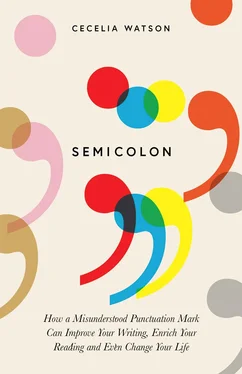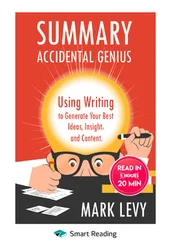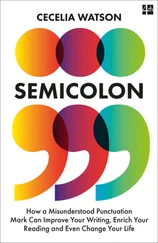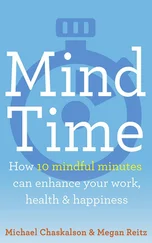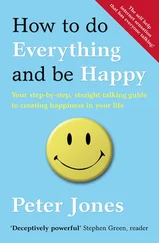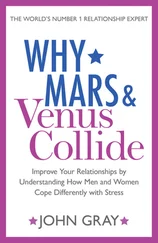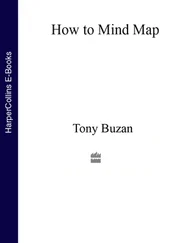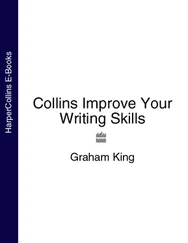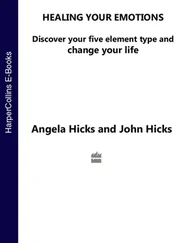This process of moving from particular examples to general principles is known as ‘induction’. Faced with the shift towards an inductive method modelled on science, mid-century grammarians waffled on the proper place of punctuation in their guidebooks. Was punctuation part of orthography, the study of how a language should be written? Was it part of prosody, how language should sound? Or did punctuation fall under the heading of syntax, the study of how language should be structured? The problem sparked vigorous debate. If punctuation were to be part of prosody, how could it be taught with the properly scientific inductive method? A student could hardly be expected to inductively derive rules from the rich, subtle, and infinitely varied rhythms that punctuation created in texts!
Uncertain of punctuation’s proper classification, some grammarians simply left it out of their books entirely, sidestepping the problem of making rules that would be appropriate for an observation-based, natural science of language. Where punctuation was included in mid-1800s manuals, however, writers were given ample opportunity for semicolon use. In George Payn Quackenbos’s 1862 An English Grammar , four possibilities for semicolon usage were given, and students were instructed to use a semicolon (not a colon, as we moderns would) to introduce a list of items.
Quackenbos’s rules for the semicolon.
Nowadays all style guides advise against using a semicolon to link together an independent and a dependent clause. In other words, the parts of a sentence separated by a semicolon must be able to stand on their own grammatically, so that they could be complete sentences if they wanted. But most nineteenth-century grammarians considered it perfectly acceptable to link together an independent and a dependent clause using a semicolon. If the author thought it sounded right, no need to meddle. As the grammarians’ push towards logic, natural science, and induction continued, however, punctuation became decoupled from prosody and personal preference. By the 1880s, grammarians distinguished between rhetorical pauses, which were akin to pauses in speaking and were not to be marked by punctuation; and grammatical pauses, which required punctuation in order to make the structural and logical attributes of a sentence clear.
There were a few holdouts who resisted the new model of grammar. W. C. Fowler, for instance, advocated applying punctuation marks to signal rhetorical pauses, and in his 1881 grammar it was still permissible to use a semicolon between an independent and a dependent clause. But by his own admission, Fowler was the exception rather than the rule: by the time Fowler published his book, grammarians were treating the semicolon like a controlled substance. They generally prescribed them only for use between independent clauses, or to separate items in a list that were long enough to be subdivided with commas. An 1888 report on punctuation by the California State Board of Education called attention to the fact that there was ‘but one use of the semicolon’ in its lessons, its function restricted to separating independent clauses that contained commas. One hundred and thirty years had passed between Robert Lowth’s grammar, which had envisioned punctuation marks as musical elements in prose, and this report, with its strict logic-based rules. In that time, the function of the semicolon had grown narrower and narrower until it had been whittled down to one or two applications.
This narrowing, as we’ve seen, happened in large part because grammar books were part of greater cultural and aesthetic trends in the Western world that privileged natural-scientific knowledge above other types of study; and in responding to those pressures, grammarians devised systems of punctuation that fitted comfortably with the ideals and the formats employed in science textbooks. Where had a century of rules, of grammars labelled ‘true’ and ‘real’ and ‘improved’, of grammars sidling up to natural science – where had all this got the generations of English speakers who had grown up immersed in books devoted to these principles? Into trouble, that’s where, according to commentators. ‘Where is the man that can tell why a comma is inserted instead of a semicolon; a semicolon, instead of a period [full stop]; a colon, instead of a period?’ asked an 1899 American newspaper editorial. ‘And yet, the science of punctuation is almost as definite as the science of mathematics, and, with few exceptions, a reason can be given for every mark inserted.’ The rules were definitive, and yet their application varied wildly, and this divergence was apt to haunt a person all his or her life. As the Boston Daily Globe sombrely intoned:
From childhood’s earliest hour, or from that early hour in which one graduates from pothooks and hangers, and his wavering hand begins to form scraggly letters, those mysterious little hieroglyphics that must be placed somewhere in every sentence confront him, and confuse him, and all through his natural life get him in trouble. Then, perhaps, after death his heirs will call each other names and invoke the courts of law because he were indiscreet enough to use a comma where he should have put a semicolon.
The Globe had good reason to raise the spectre of a punctuation-related legal battle; the new rule-based approach to punctuation had already begun to trouble the court system. Now it was not just the letter of the law but the punctuation separating those letters that judges and juries had to negotiate. Another commentator, for the Indianapolis Journal , concurred: citing four specific instances in which the semicolon had ‘made trouble in the laws’ by creating ambiguity in statutes, the author ascribed this trouble to ‘inability to fix the function of the semicolon’. Old grammar books had given the rules of punctuation in terms of pauses, and ‘if those who have been writing rules for punctuating compositions had stopped there, we would not have had all this trouble, but these teachers have been going on making new rules for years until no one can undertake to follow them, but each punctuates according to his pleasure, rather than his familiarity with the rules’. Finding the rules unhelpful, the public had run screaming in the opposite direction, punctuating willy-nilly. Therefore, the commentator opined, either the court system should write a legal treatise to define punctuation marks once and for all, or it should resolve to ignore punctuation altogether in its rulings.
But unbeknownst to the commentator, the American court system had already given the latter strategy a try, relying on old British case law for precedent. The Massachusetts Supreme Court had issued a ruling saying that punctuation had no part in statutes. This attempt to assert that Justice ought to extend her blindness to commas and semicolons was over-optimistic, and didn’t obviate any of the interpretive problems with which the law had to contend. Any remaining hope that the law could somehow escape the challenges posed by punctuation went out the window when a semicolon set about wreaking havoc up and down the Northeast Corridor in a dramatic Massachusetts court case that caused six years of controversy in courtrooms, in legislative debates, and in the streets.
Конец ознакомительного фрагмента.
Текст предоставлен ООО «ЛитРес».
Прочитайте эту книгу целиком, на ЛитРес.
Безопасно оплатить книгу можно банковской картой Visa, MasterCard, Maestro, со счета мобильного телефона, с платежного терминала, в салоне МТС или Связной, через PayPal, WebMoney, Яндекс.Деньги, QIWI Кошелек, бонусными картами или другим удобным Вам способом.
